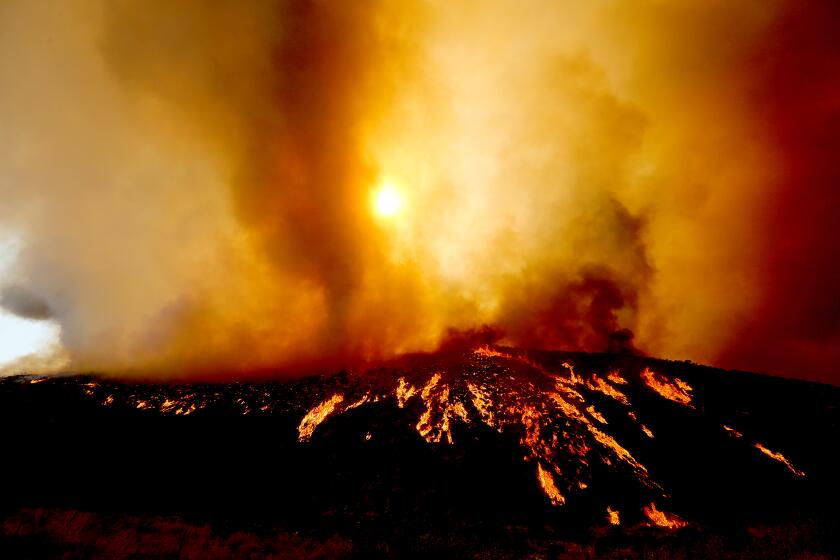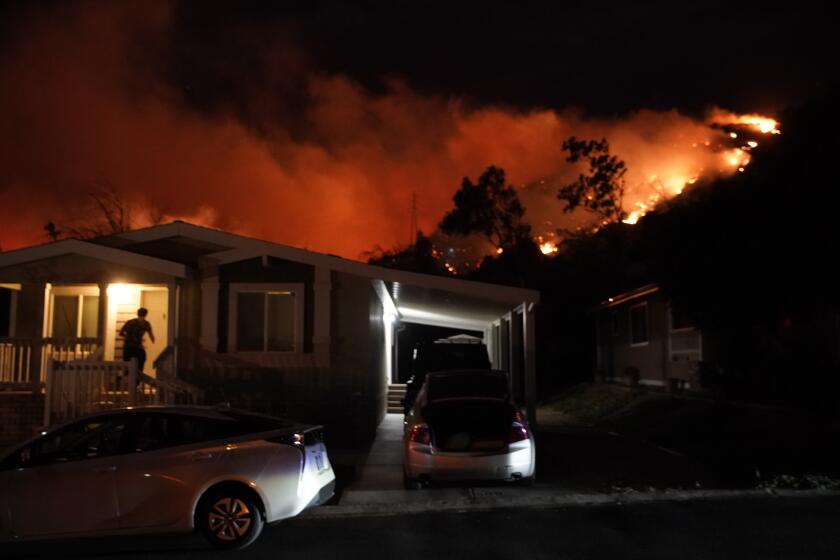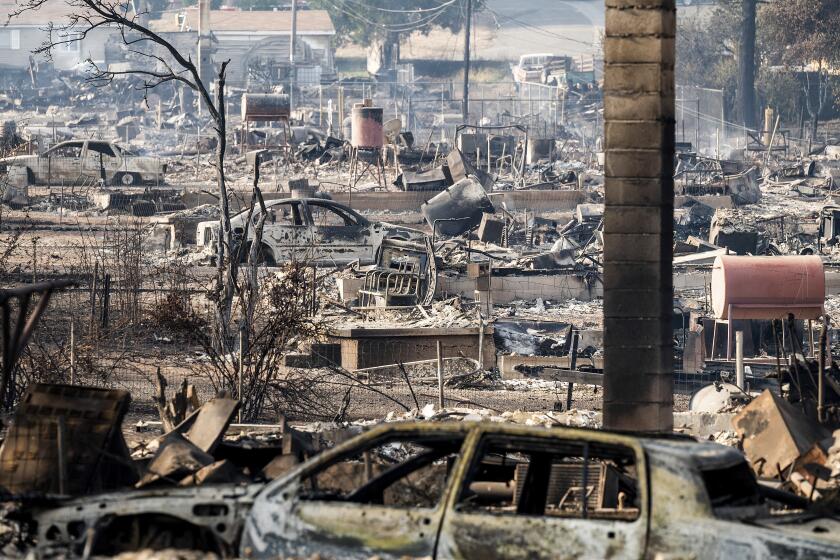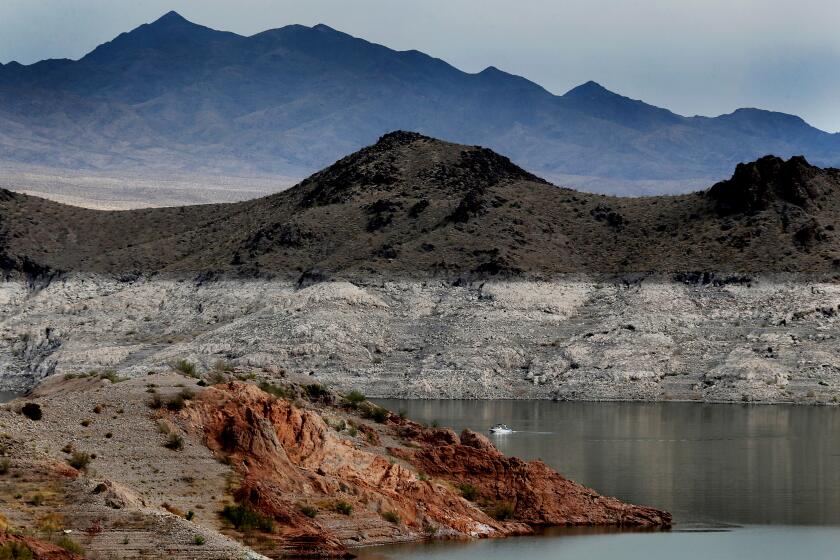California fires killing people before they can escape their homes, making seconds count
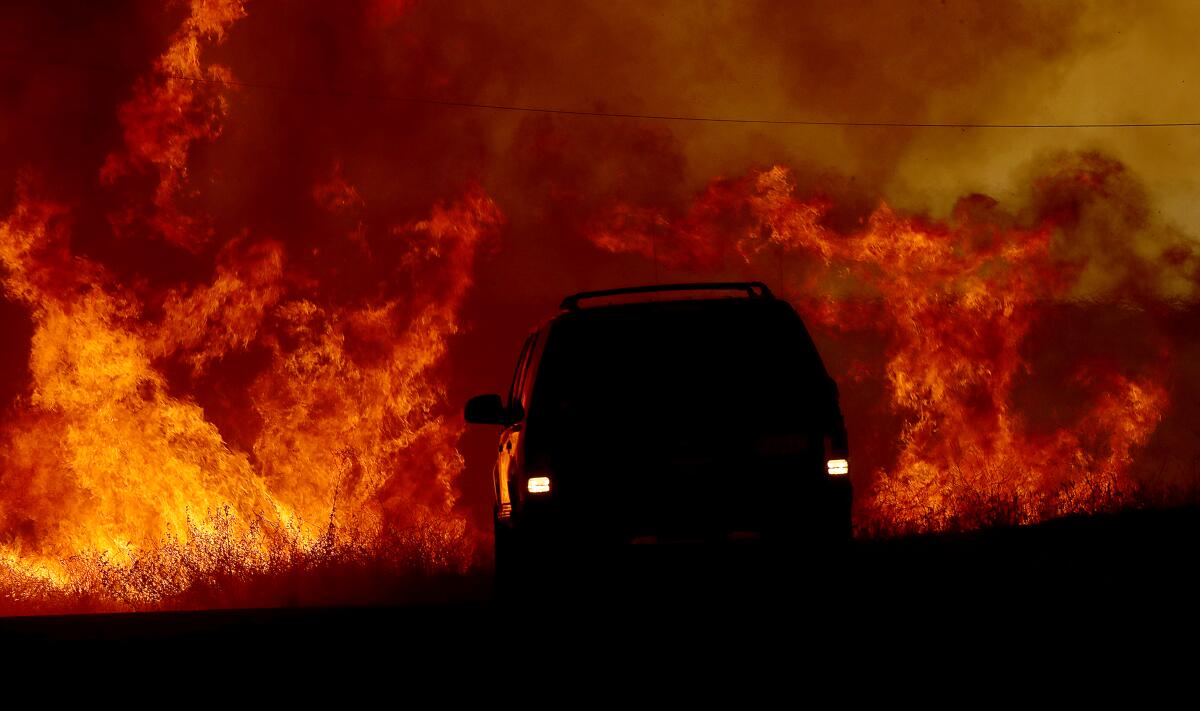
- Share via
HEMET, Calif. — The sound of exploding propane tanks filled Avery Canyon on Monday afternoon as flames from the Fairview fire gnawed at a grassy ridge near Jeremy Fields’ ranch home.
A sheriff’s deputy called out with a loudspeaker, urging Fields and his family to evacuate. He and his wife, Gladys Nicomedez, gathered what they could — insurance papers, some clothes, their son’s inhalers and medication — before gunning it down Gibbel Road, the only way into and out of their hillside neighborhood.
The family was among the last to leave the canyon. They would learn later that the fast-moving fire had overcome their neighbors, killing them both.
“If we wouldn’t have left the second we left, we would have been blocked in,” Fields recalled.
The fire tore through 2,000 acres around Hemet on Monday and continued to grow Tuesday .
The fire was one of two deadly blazes in California during the broiling hot Labor Day weekend, with the Mill fire in Siskiyou County also claiming two lives and bringing the year’s wildfire death toll to nine, including four killed in Northern California’s McKinney fire and one in Petaluma’s Roblar fire earlier this summer. Officials said the sobering number underscores how the state’s climate change-fueled blazes are outpacing emergency alert systems and posing new threats to residents.
“What we’ve seen almost over the last 10 years now is a huge change in the ways fires have been burning throughout California,” said Jon Heggie, a battalion chief with the California Department of Forestry and Fire Protection. “They burn with such increased speed and velocity and intensity that it gives residents very little time sometimes to escape fires, just because the fuels are so receptive and burn so much hotter and so much faster.”
When you’re ordered to evacuate, you need to go as quickly as possible. Here are the essentials experts say to pack.
The frequency of the danger also appears to be accelerating: Eleven of the state’s 20 deadliest fires have occurred since 2000, according to Cal Fire. Of those, seven have occurred since 2017.
That’s partly because it’s getting harder to reach residents — or even warn them — as fires move faster than ever because extreme heat and drought are priming the landscape to burn. Most of the fatalities this year happened within the first hours of the fires.
Heggie said people in rural communities are particularly at risk — not only because they are surrounded by combustible wildlands but also because cellphone service can be spotty and emergency messages might not reach them.
“They really have to be mindful of their situational awareness and understanding that if a fire were to start, their reaction time is not very much because of ... the way vegetation is in California,” he said.
The Fairview fire, for example, sparked Monday afternoon amid 111-degree heat and seared through 2,000 acres in its first six hours in what officials described as a “critical rate of spread.” Incident commander Josh Janssen said the two people who were killed were attempting to flee the Avery Canyon area when they were trapped by flames.
“The challenge was what we’ve been talking about for years — the unseasonably dry fuel conditions,” Janssen told reporters Tuesday morning. He said the fire was also “in alignment” with wind and topography in the area, which helped it spread quickly.
“That, coupled with the drought-stricken fuels, their dry nature in that canyon, and the alignment is what allowed that fire to rapidly expand and overcome some of the citizens,” he said.
A similar scene played out at the Mill fire, which became the second deadly fire in Siskiyou County this summer, after the McKinney fire in late July. The Siskiyou County Sheriff’s Office said the two people who were killed by the Mill fire — a 73-year-old woman and 66-year-old woman — were found in separate locations, but provided few additional details.
The fire tore through 2,000 acres around Hemet on Monday and continued to grow Tuesday .
Mill fire public information officer Aaron Johnson said climate factors played a significant role as the blaze grew about 4,000 acres in its first 12 hours after igniting Friday afternoon. It fed on buildings, homes and vegetation in the community of Lincoln Heights in Weed.
“We were kind of in a red flag warning this weekend — so high temperatures, low humidity — which made the fuels very receptive to any potential start,” Johnson said. He added that vegetation in the area is “basically in the 97th percentile for dryness.”
“So critically dry fuels, combined with the weather, the wind and the temperature and the humidity being what it was, helped the fire spread,” he said.
But the speed of the fires is only one part of the challenge, according to Shane Reichardt, a spokesman for the Riverside County Emergency Management Department. Reichardt said technology can sometimes make it harder — not easier — to reach residents in emergency situations as more and more people ditch landlines and rely on opt-in cellphone systems for crucial information.
“Technology is an amazing thing, but it definitely creates some challenges that there aren’t easy answers for,” he said.
Whereas landline phones are automatically registered with the county’s emergency alert system, Alert RivCo, cellphone providers are not required to provide the agency with lists of their customers and addresses, Reichardt said — meaning people have to voluntarily enroll. What’s more, whereas older landlines may work during power outages, many digitally powered home phones do not.
Reichardt said the agency does have the ability to ping cellphones near specified cell towers during an emergency, but that doesn’t mean it will reach everyone who needs the information, such as parents working in a different area while their kids are at home near a fire.
“One of the biggest problems is that a lot of people don’t know that it’s not automatically included,” he said of the county system. “People were used to having landline phones, and so they never had to do anything before. And then you have a younger generation where when they see a wireless emergency alert, they assume they’re already getting everything they need to get.”
People who purchase prepaid phones without contracts or plans are also difficult to reach, as are people visiting the area or just passing through who are not registered with the county alert system, he said.
The Mill fire in Siskiyou County destroys the historically Black neighborhood of Lincoln Heights in Weed, officials said.
Brandi Swan, a spokeswoman with the Riverside County Sheriff’s Department, said 3,467 homes near the Fairview fire were placed under evacuation orders on the first day. She estimated that a little more than 12,100 residents lived in those areas. The department deployed more than 100 deputies to go door to door and play public announcement messages from their vehicles, she said.
But even then, some people opted not to leave and instead wanted to shelter in place.
“You would think more people would take it seriously because it’s so fast-moving, and that’s why we try and do such a large evacuation area because the shift in winds, the weather is unpredictable, and fire moves fast,” Swan said.
Reichardt said the county is trying to encourage all residents to enroll in Alert RivCo through email blasts and social media, but it doesn’t have much funding for big advertising campaigns or physical mailers.
When asked how many residents have enrolled, he didn’t have a precise number but said “it’s probably in the area of 20%.”
Recurring drought and rising temperatures have already begun to alter the landscape of California and the American Southwest, researchers warn.
With more than 97% of the state under severe, extreme or exceptional drought, even the best technology is having difficulty keeping up with California’s fires. The West’s extreme dryness now ranks as the driest 22-year period in at least 1,200 years. The heat doesn’t help, and can make it harder for first responders to do their jobs while simultaneously increasing the risk of conflagrations.
“It is definitely no coincidence that these fast moving fires are occurring during an intense heatwave,” UCLA climate scientist Park Williams said via email.
Some rare August precipitation in the southern Sierra Nevada and Southern California mountains may have helped somewhat, “but the forecast for intense heat to continue for several more days means there is still time for many more fires to erupt, especially if the tropical storm coming up the Baja coast causes a high frequency of lightning strikes later this week, similar to what tropical storm Fausto did in August 2020,” Williams said.
In 2020, lightning strikes helped fuel what eventually became the worst wildfire season in state history.
Reichardt said such threats are all the more reason for people to have go bags and evacuation plans ready in advance.
“If you see fire in the area, we would much rather people self-evacuate, get out of the neighborhood, and then figure out ‘Do I need to be evacuated?’” he said. “Basically, we don’t want people to wait if they feel unsafe.”
By early Tuesday morning, the Red Cross evacuation shelter at Tahquitz High School housed 43 residents who had fled the Fairview fire, including Fields and Nicomedez. More were expected as authorities issued additional evacuation orders for other hillside neighborhoods.
“It just happened so fast,” Fields said of the fire. “I don’t think anybody could have prepared for that.”
More to Read
Sign up for Essential California
The most important California stories and recommendations in your inbox every morning.
You may occasionally receive promotional content from the Los Angeles Times.
